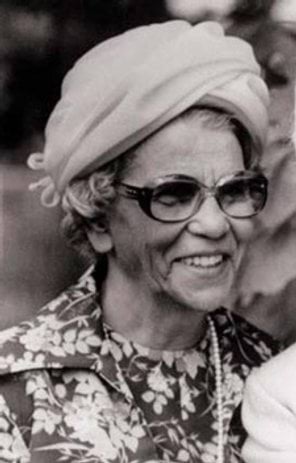
- Inducted:
- 2012
Lady Gladys Nicholls was a leading Aboriginal activist whose dedicated community service and commitment to advancing Aboriginal rights was an inspiration to many, particularly young women.
The third of six children, Lady Gladys was born on the Cummeragunja Mission in New South Wales in 1906. Her mother, Alice Campbell, was a Yorta Yorta woman and her father, Mehra Baksh, a migrant from India. He ran a general store in Barmah, on the Victorian side of the Murray River. Gladys attended school at the Mission, but left at a young age to work with her father and later took a job milking cows at a nearby station.
At the age of 19 years, Lady Gladys married Herbert Nicholls, with whom she had three children. The couple lived at Cummeragunja until 1939, when they joined a mass walk-off in protest against the harsh conditions and poor treatment experienced by residents of the Mission. Eventually they relocated to Melbourne, where Lady Gladys worked in a munitions factory in Maribyrnong. Her connection to Cummeragunja, however, always remained strong and she would visit regularly.
Tragically, Lady Gladys lost her husband from injuries sustained in a car crash in 1942. Herbert's younger brother Pastor Doug Nicholls — an emerging Aboriginal leader — provided support to the family at the time. Lady Gladys and Pastor Doug were later married, becoming partners in life and in work. Lady Gladys taught Sunday school at her husband's church in Gore Street, Fitzroy. As Pastor Doug rose to prominence, Lady Gladys provided invaluable support as the bedrock of the family. They had two children, who grew up to have significant roles in Aboriginal affairs.
After the Second World War, as the Aboriginal population of inner Melbourne grew, so too did the social problems and hardships born of poverty. Lady Gladys was among a group of resourceful Aboriginal women who worked together to improve the living conditions and wellbeing of their community — a community still denied full citizenship rights and subject to discriminatory state laws. Countless lives were improved as a result of their tireless, unpaid work.
In the absence of government support, fundraising was crucial to the success of the women's activities. They organised annual balls or sold homemade goods at weekly street stalls. Lady Gladys had always possessed business acumen — she ran a food truck for a time and sewed dresses which she would sell at Cummeragunja. These skills were put to good use when she opened a number of successful opportunity shops around Fitzroy to help raise much needed funds. The shops were staffed by volunteers, including Lady Gladys, who liked nothing more than a friendly chat with customers.
Over the years, Lady Gladys provided care and protection to many young people, in addition to her own children. With her house often filled to capacity, she saw a need for a safe place where Aboriginal girls, in particular, could stay when they came to the city in search of work. A committee was established and, as a result of its efforts, a hostel was opened in Northcote in 1956. Lady Gladys involved herself in the day-to-day running of the facility, which was later renamed after her. Its success inspired a similar hostel for boys.
When the Aborigines Advancement League (AAL) was established in 1957, Lady Gladys co-founded its Women's Auxiliary and travelled around the state to recruit members. The Auxiliary's contribution ranged from the provision of school supplies to hospital visits and support for ex-prisoners. Lady Gladys would also organise annual Christmas events for children and the underprivileged.
Since the 1930s, the goal of Aboriginal policy in Victoria had shifted from segregation to assimilation. With Aboriginal identity at risk of being eradicated, state-based activists began to collaborate with each other to raise awareness of their cause on the national stage. Lady Gladys advocated raising the status of Indigenous Australians in wider society. She was involved with several national bodies, including the Federal Council for the Advancement of Aboriginal and Torres Strait Islanders (FCAATSI) and the National Aboriginal and Islander Women's Council, of which she was Secretary and Victorian State President.
Lady Gladys campaigned with her husband in the lead up to the 1967 referendum. It delivered constitutional amendments that saw Indigenous Australians counted in the national Census for the first time and the Commonwealth Parliament freed to legislate on Indigenous issues. The success of the referendum was a significant and symbolic moment in the rights movement.
During the 1970s, when her husband was knighted and later appointed Governor of South Australia, Lady Gladys performed the official duties required of her with aplomb. Her passion for Aboriginal rights remained undiminished for the remainder of her life.
Lady Gladys passed away in 1981 and was buried at Cummeragunja. Her husband was laid to rest beside her in 1988. A statue of the couple stands in Parliament Gardens in Melbourne in honour of their work. In 2008, Lady Gladys was inducted to the Victorian Honour Roll of Women.
Remembered for her intelligence and firm but gentle demeanour, Lady Gladys Nicholls worked hard to ensure that those around her were given every opportunity to reach their full potential. To her family and the wider community she was, above all, a source of great strength whenever it was needed most.
Updated

